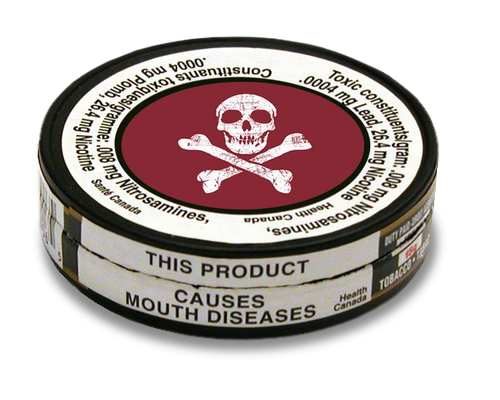Facts about Smokeless Tobacco
Smokeless tobacco use is growing among young people. Smokeless tobacco includes chew, spit, dip, snuff, snus and a host of new dissolvable products—none of these are safe. In fact, smokeless tobacco use among Hoosier boys is about 11% and has remained unchanged while cigarette smoking has declined.
For decades the tobacco industry has used images that make tobacco use appealing to youth. It not surprising that marketing plays an important role in attracting users – particularly youth. The 2012 Surgeon General’s report, Preventing Tobacco Use among Youth and Young Adults, found that the “integration of product design with marketing helped to reverse the mid-twentieth century decline in smokeless tobacco use and spurred a rapid increase in smokeless tobacco use by adolescents and young adult males.” Consider these facts:
HOW CAN I GET HELP QUITTING SMOKELESS TOBACCO?
If you are ready to quit, there is help. Quit Now Indiana is making many resources available to you at no cost—FREE! 1.800.Quit.Now is a free service for all Hoosiers age 13 and over. Trained Quit Coaches are waiting to help you successfully quit tobacco use.
WHAT IS SMOKELESS TOBACCO?
Smokeless tobacco is tobacco that is not burned. It is also known as chewing tobacco, oral tobacco, spit or spitting tobacco, dip, chew, and snuff. Most people chew or suck (dip) the tobacco in their mouth and spit out the tobacco juices that build up, although “spitless” smokeless tobacco has also been developed. Nicotine in the tobacco is absorbed through the lining of the mouth. There are two main types of smokeless tobacco:
Chewing tobacco, which is available as loose leaves, plugs (bricks), or twists of rope. A piece of tobacco is placed between the cheek and lower lip, typically toward the back of the mouth. It is either chewed or held in place. Saliva is spit or swallowed.
Snuff, which is finely cut or powdered tobacco. It may be sold in different scents and flavors. It is packaged moist or dry; most American snuff is moist. It is available loose, in dissolvable lozenges or strips, or in small pouches similar to tea bags. The user places a pinch or pouch of moist snuff between the cheek and gums or behind the upper or lower lip. Another name for moist snuff is snus (pronounced “snoose”). Some people inhale dry snuff into the nose.
CAN A USER GET ADDICTED TO SMOKELESS TOBACCO?
All tobacco products, including smokeless tobacco, contain nicotine, which is very addictive. Users of smokeless tobacco and users of cigarettes have comparable levels of nicotine in the blood. In users of smokeless tobacco, nicotine is absorbed through the mouth tissues directly into the blood, where it goes to the brain. Even after the tobacco is removed from the mouth, nicotine continues to be absorbed into the bloodstream. Also, the nicotine stays in the blood longer for users of smokeless tobacco than for smokers. The level of nicotine in the blood depends on the amount of nicotine in the smokeless tobacco product, the tobacco cut size, the product’s pH (a measure of its acidity or basicity), and other factors.
A Centers for Disease Control and Prevention study of the 40 most widely used popular brands of moist snuff showed that the amount of nicotine per gram of tobacco ranged from 4.4 milligrams to 25.0 milligrams. Other studies have shown that moist snuff had between 4.7 and 24.3 milligrams per gram of tobacco, dry snuff had between 10.5 and 24.8 milligrams per gram of tobacco, and chewing tobacco had between 3.4 and 39.7 milligrams per gram of tobacco.
IS SMOKELESS TOBACCO A SAFER ALTERNATIVE TO SMOKING CIGARETTES?
There is no safe level of tobacco use. All tobacco products are harmful and cause cancer, the use of all tobacco products should be strongly discouraged. People who use tobacco should quit.
The Surgeon General's report concluded that the use of smokeless tobacco “is not a safe substitute for smoking cigarettes. It can cause cancer and a number of noncancerous oral conditions and can lead to nicotine addiction.” Furthermore, a panel of experts convened by the National Institutes of Health (NIH) in 2006 stated that the “range of risks, including nicotine addiction, from smokeless tobacco products may vary extensively because of differing levels of nicotine, carcinogens, and other toxins in different products.”
SHOULD SMOKELESS TOBACCO BE USED TO HELP A PERSON QUIT SMOKING?
There is no scientific evidence that using smokeless tobacco can help a person quit smoking. For help with quitting, ask your doctor about individual or group counseling, telephone quitlines, or other methods. Smokeless tobacco is not an approved therapy for quitting.
ARE THERE HARMFUL CHEMICALS IN SMOKELESS TOBACCO?
There is no safe form of tobacco. At least 28 chemicals in smokeless tobacco have been found to cause cancer. The most harmful chemicals in smokeless tobacco are tobacco-specific nitrosamines, which are formed during the growing, curing, fermenting, and aging of tobacco. The level of tobacco-specific nitrosamines varies by product. Scientists have found that the nitrosamine level is directly related to the risk of cancer.
In addition to a variety of nitrosamines, other cancer-causing substances in smokeless tobacco include polonium–210 (a radioactive element found in tobacco fertilizer) and polynuclear aromatic hydrocarbons (also known as polycyclic aromatic hydrocarbons).
DOES SMOKELESS TOBACCO CAUSE CANCER?
According to the Centers for Disease Control and Prevention, some of the health problems of smokeless tobacco include esophageal cancer, lip cancer, tongue cancer, mouth cancer and pharynx cancer.
DOES SMOKELESS TOBACCO CAUSE OTHER DISEASES?
Smokeless tobacco use can also increase the risk for death from heart disease and stroke. Using smokeless tobacco may cause gum disease, and oral lesions other than cancer, such as leukoplakia (precancerous white patches in the mouth).
MAKE THE COMMITMENT
You must be committed to live tobacco-free. Start now.
Congratulations on making the decision to quit.


